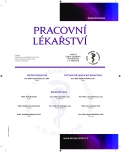Saturation diving – the Hydronaut Project
Authors:
Sázel Miloš 1; Boháček Pavel 2
Authors‘ workplace:
Ústav leteckého zdravotnictví Praha ředitel MUDr. Petr Chmátal, Ph. D., MBA
1; Ústřední vojenská nemocnice – Vojenská fakultní nemocnice Praha ředitel plk. prof. MUDr. Miroslav Zavoral, Ph. D.
2
Published in:
Pracov. Lék., 66, 2014, No. 2-3, s. 85-89.
Category:
Review article
Overview
In the history of saturation diving Czechoslovakia occupied the third position in nineteen sixties after France and the USA. The record dive of the Permon project (102 h in 25m depth) was made in 1967.
The Hydronaut Project connecting the saturation stay with a simulation in outer space was published in 2010. A living module is being completed and the health and psychical state of five divers was completed, while three of them are to stay in the depth for 7 days. The limit of the mission depth is related to the risk of cumulative oxygen lung toxicity. In conditions of breathing air, the module may be maximally immersed to 20 m below surface. In view of the dissolved gases in tissues, maximum change of depth in the 10 m range must be observed for the way out of the module. The final decompression could last about 35 h with 12 stops graduated by 1.5 m.
A final goal of the Hydronaut Project is to investigate the effect of stress load during the stay in a closed, isolated, limited and dangerous environment. The authors are planning introduce a course of special physical and psychological preparation, which will make use of the knowledge of the saturation diving as well as from the analogous space studies. The main ambition of the project is to contribute its knowledge and experience to the area of European pilot spaceflights.
Keywords:
decompression – decompression illness – nitrogen – spaceflight – oxygen – lung toxicity – diving – saturation – air
Sources
1. 79/2013 Sb., Vyhláška o provedení některých ustanovení zákona č. 373/2011 Sb., o specifických zdravotních službách (vyhláška o pracovně lékařských službách a některých druzích posudkové péče).
2. 103/2005 Sb., Vyhláška o zdravotní způsobilosti k vojenské činné službě.
3. A guide to the work in compressed air regulations 1996, reprint 2002. Dostupný z: <http://www.hseni.gov.uk/l96_guide_to_work_in_compressed_air_regulations_1996.pdf>.
4. Aquarius. Dostupný z: <http://aquarius.fiu.edu/>.
5. Aquarius underwater laboratory. Dostupný z: http://oceanexplorer.noaa.gov/technology/diving/aquarius/aquarius.html.
6. Doporučení pro posuzování zdravotního stavu sportovních potápěčů. Dostupný z: http://www.cshlm.cz/dokumenty/Dopor_postup_posuzovani_zdr_stavu_SVL.pdf.
7. Edel, O. P. Criteria for interim decompression tables for caisson and tunnel workers. Nat. Inst. Occupat. Safety Health., 1980, 68 s. Dostupný z: <http://www.cdc.gov/niosh/topics/decompression/nioshDeveloped.html>.
8. Flook, V. Excursion tables in saturation diving – decompression implications of current UK practice. Res. Rep., s. 244. In Health and Safety Information. Sudbury: Unimed. Sci. Limit. 2004, 25 s.
9. Gernhardt, M. L., Labertsen, Ch. J. Commercial diving. In Brubakk, A. O., Neuman, T. S. Physiology and Medicine of Diving. 5th ed. Philadelphia: Saunders Elsevier Sci. 2003–2007, s. 29–44.
10. Hamilton, R.W. Tolerating exposure to high oxygen levels: Repex and Other Methods. Mar. Tech. Soc. J., 23, 1989, č. 4, s. 19–25.
11. Hamilton, R.W. Tolerating oxygen exposure. South Pacif. Underwat. Med. Soc. J., 27, 1997, č. 1, s. 43–47.
12. Hamilton, R.W. et al. REPEX: Development of Repetitive Excursions, Surfacing Techniques, and Oxygen Procedures for Habitat Diving. Nat. Undersea Res. Prog. Tech. Rep., 88-1A. NOAA 1988. Dostupný z: http://rubicon-foundation.org.
13. Heyder, E., Jacey, M. J. Biochemical studies of saturation and saturation/excursion dives breathing O2-N2 mixtures. Aviat Space Environ. Med., 50, 1979, č. 1, s. 51–59.
14. IMCA Publications. Inter. Marine Contr. Ass., Dostupný z: <http://www.imca-int.com/>.
15. International Consensus Standard for Commercial Diving and Underwater Operation. Assoc. Div. Contract. Internat., Ed. 6, 2011, 328 s.
16. Jahns, J. Potápění s nitroxem II: učebnice pro stupeň CMAS Advanced Nitrox Diver. Hlučín: Svaz potápěčů ČR 2007, 60 s.
17. Jahns, J. Podklady k výpočtům dekompresních tabulek Bühlman/SUSV 1986. Hlučín: Svaz potápěčů ČR 2008, 32 s.
18. Leitch, D. R. Complication of saturation diving. J. Royal Soc. Med., 1985, 78, s. 634–637.
19. Liew van, H. D., Flynn, E.T. Direct ascent from air and N2-O2 saturation dives in humans: DCS risk and evidence of a threshold. Undersea Hyperbar. Med., 2005, 32, č. 6, s. 409–419.
20. Murray, R. D., Jacey, M. J. Shallow habitat air dives I and II: Human hematologic responses to compressed air saturation diving. Aviat. Space Environ. Med., 1977, Nov., s. 1012–1017.
21. NORSOK STANDARD U-100. Manned underwater operations. Edition 3. Lysaker: Standards Norway April 2009. 64 s. Dostupný z: http://www.standard.no/en/sectors/energi-og-klima/petroleum/norsok-standard-categories/u-underwater-op/u-100-edition-2-july-2008/.
22. Novomeský, F. Potápěčská medicína. Martin: Osveta 2013, 415 s.
23. U.S. Navy Diving Manual. Rev. 6, Vol. 2, Air Diving Operation. Chap. 15, Saturation Diving. Washinton: U. S. Gov. Print. Office 2008, 39 s.
24. Vorosmarti, J. Jr. A very short history of saturation diving. Histor. Diving Times, 1997, Winter, 20, 8 s.
25. Weathersby, P. K., Survanshi, S. S., Hays, J. R., Maccailum, M. E. Statistically based decompression tables III: Comparative risk using U.S. NAVY, British, and Canadian standard air schedules. NMRI 86-50. Nav. Med. Res. Inst. Bethesda: NavMedCom, 1986, 23 s.
26. Workman, R. D. Calculation of air saturation decompression tables. Research Rep. 11-57. Washington: U. S. NAVY Exp. Div. Unit 1957, 16 s.
27. Workman, R. D. Calculation of decompression schedules for nitrogen-oxygen and helium-oxygen dives. Res. Rep. 6-65. Washington: U.S. NAVY Exp. Div. Unit 1965, 33 s.
Labels
Hygiene and epidemiology Hyperbaric medicine Occupational medicineArticle was published in
Occupational Medicine

2014 Issue 2-3
Most read in this issue
- Lateral epicondylitis of humerus in clinical practice of the occupational diseases ward
- Saturation diving – the Hydronaut Project
- Kinesiotherapy in the carpal tunnel syndrome
- Low back pain as an occupational disease
